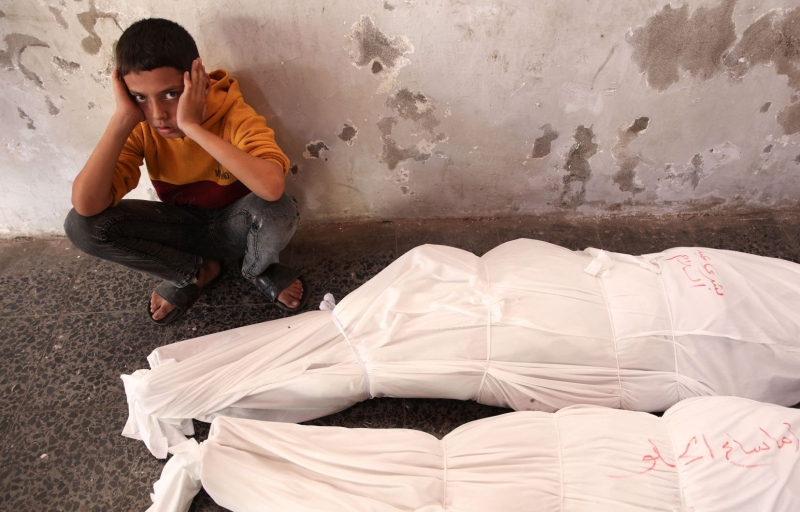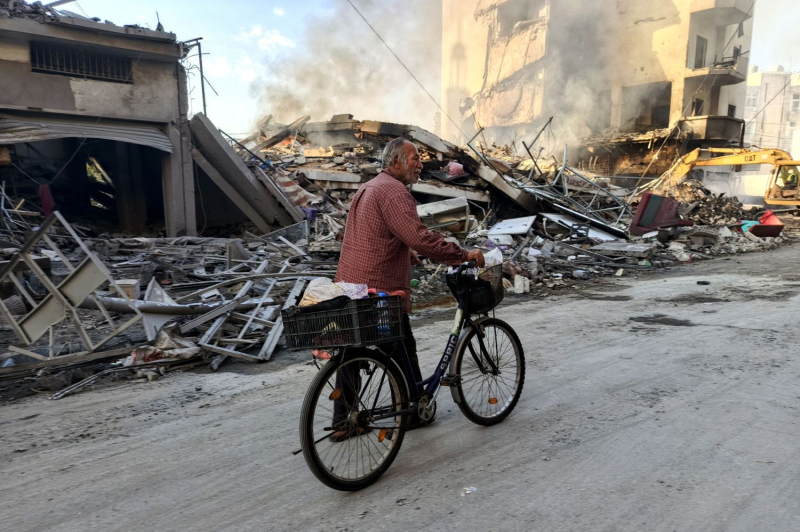
Photo: Omar Al-Qattaa Agence France-Presse A Palestinian child sits near the wrapped bodies of two victims of an Israeli strike, Thursday, outside al-Maamadani hospital.
Chloé Rouveyrolles-Bazire – Agence France-Presse and Jonathan Sawaya – Agence France-Presse in Jerusalem
Published at 9:23
- Middle East
American envoys are to hold talks in Israel on Thursday to try to move forward with a ceasefire in Lebanon and the Gaza Strip, at a time when the Israeli army is maintaining military pressure on Lebanese Hezbollah and Palestinian Hamas.
Despite the blows inflicted on Hezbollah, the pro-Iranian movement continues to fire rockets into Israel, where five civilians were killed in Metula in the north, while Israeli troops have carried out new deadly strikes in Gaza and Lebanon.
Israel vowed to destroy Hamas after the Islamist movement attacked its territory on October 7, 2023, and launched a devastating offensive in Gaza. The following day, in support of Hamas, Hezbollah opened a front against its Israeli neighbor before cross-border fire escalated into open warfare in September.
With the November 5 U.S. presidential election just days away and efforts to broker a ceasefire underway, White House officials Amos Hochstein and Brett McGurk traveled to Israel to discuss “a political solution” in Lebanon and “ways to end the conflict in Gaza,” the State Department said Wednesday.
They are expected in Israel on Thursday, according to Israeli media.
The Americans hope to reach a framework agreement in the coming days, according to the newspaper Israel Hayom, while Israeli leaders want to neutralize Hezbollah in the southern border regions of Lebanon to allow the return of some 60,000 displaced people in northern Israel, a target of the rockets fired from Lebanon.
According to Israeli Channel 12, Israel is demanding the withdrawal of Hezbollah north of the Litani River in southern Lebanon, the deployment of the Lebanese army on the Israeli border, an international mechanism to enforce the truce and a guarantee that Israel will retain its freedom of action in the event of threats.
Israeli officials have also said that soldiers engaged in a ground offensive in southern Lebanon since September 30 will not withdraw from the area until an agreement is reached that meets Israel's security requirements.

Photo: Kawnat Haju Agence France-Presse An elderly man walks with his bicycle near a building destroyed by an Israeli strike, October 31, in Abbasiyeh.
Dissociation of the fronts
On Wednesday, Hezbollah's new leader, Naim Qassem, said his movement could continue to fight Israel, while saying it was ready for a ceasefire “under conditions,” without specifying which ones.
On the same day, Lebanese Prime Minister Najib Mikati said Hezbollah had been “delayed” in separating the Lebanese front from the Gaza front, even though the movement has been saying for months that it wants to fight “the enemy” until the end of “Israeli aggression in Gaza.”
According to experts and the local Israeli press, this separation was made possible by the successes of the vast Israeli strike campaign that decimated Hezbollah's leadership.
According to Israeli media, a ceasefire with Hezbollah first appears increasingly likely, after Israeli Chief of Staff Herzi Halevi reported the “complete dismantling of the chain of command” of the Lebanese movement.
Israel has focused its operations in Lebanon since September 23, with Israeli strikes mainly on Hezbollah strongholds in the south and east of the country, and in the southern suburbs of Beirut.
On Thursday, six medics affiliated with Hezbollah and its ally Amal were killed in Israeli raids in southern Lebanon, according to the Lebanese Health Ministry. The city of Tyre was also the target of a strike.
There are also clashes between Israeli soldiers and Hezbollah fighters in the southern border regions, according to the Lebanese National News Agency.
More than 1,780 people have been killed since September 23 in Lebanon, according to an AFP count based on official data.
In Metula, a city in northern Israel near the border, “a farmer and four foreign farm workers” were killed by rockets fired from Lebanon, according to Mayor David Azoulai.
Read also
- After more than a year of war in Gaza, Israel is short of soldiers
- Hezbollah leader says he is ready to continue the war against Israel
- Naim Qassem, new leader of the Hezbollah
Refusal of a “temporary truce”
On Israel’s southern front, in the Gaza Strip, the Israeli army has been concentrating its deadly offensive mainly in the north since October 6, where Hamas is seeking to regroup its forces according to it.
Seven nighttime airstrikes targeted Jabalia, Beit Lahia and Gaza City, according to witnesses.
The mediating countries — Egypt, the United States, Qatar — are preparing to propose a truce “of less than a month” in Gaza, providing for an exchange of Israeli hostages for Palestinian prisoners and an increase in humanitarian aid in the ravaged territory threatened by famine according to the UN, indicated a source close to the negotiations.
But a Hamas official, Taher al-Nounou, reiterated his movement’s refusal of a “temporary truce,” demanding an Israeli withdrawal from Gaza and a “permanent end” to the war.
The Hamas attack on Israel on October 7, 2023, resulted in the deaths of 1,206 people, mostly civilians, according to an AFP tally based on official Israeli data, including hostages killed or killed in captivity.
That day, 251 people were kidnapped. A total of 97 remain hostages in Gaza, 34 of whom have been declared dead by the Israeli army.
The Israeli retaliatory offensive in Gaza has left 43,163 people dead, mostly civilians, according to data from the Hamas government's Health Ministry.

